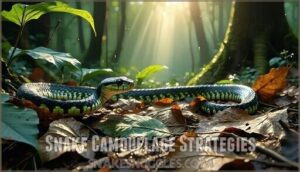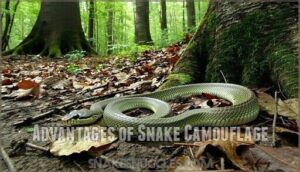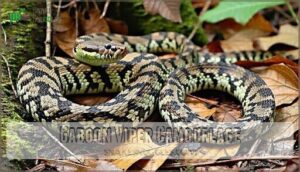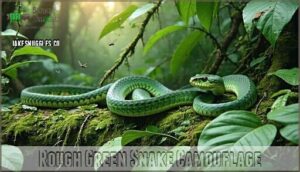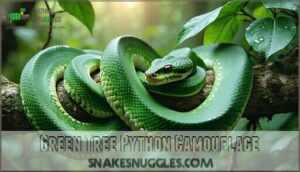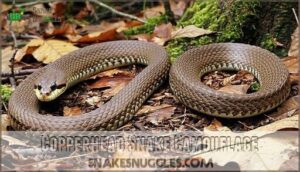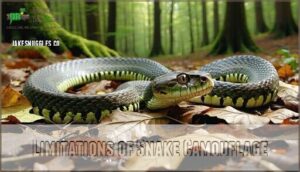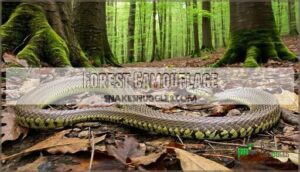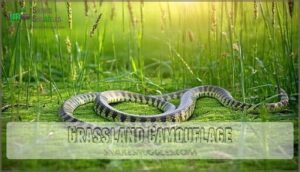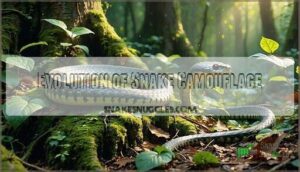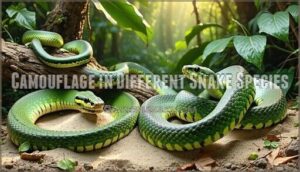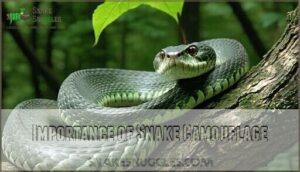This site is supported by our readers. We may earn a commission, at no cost to you, if you purchase through links.
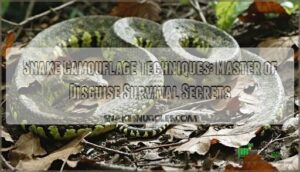
You’ll find snakes using precise color matching to blend with leaves, bark, or desert sand, while others employ disruptive patterns that break up their body outline.
Many species flatten their bodies to minimize shadows, change their coloration based on surroundings, or even mask their scent to avoid detection.
The Gaboon viper’s dead-leaf disguise and the green tree python‘s perfect leaf mimicry showcase how evolution crafted these survival artists.
These techniques serve dual purposes—helping snakes ambush unsuspecting prey while staying invisible to predators who’d love a snake snack, making them nature’s ultimate hide-and-seek champions with perfect leaf mimicry.
Table Of Contents
- Key Takeaways
- Types of Snake Camouflage
- How Snakes Camouflage Themselves
- Snake Camouflage Strategies
- Advantages of Snake Camouflage
- Examples of Effective Snake Camouflage
- Limitations of Snake Camouflage
- Snake Camouflage Techniques in Different Environments
- Evolution of Snake Camouflage
- Camouflage in Different Snake Species
- Importance of Snake Camouflage
- Frequently Asked Questions (FAQs)
- What is snake camouflage?
- How do snakes camouflage themselves?
- What is a snake’s camouflage strategy?
- Why do snakes have better camouflage?
- How do snakes camouflage?
- What are the five types of camouflage?
- How do snakes hide from their predators?
- How do copperhead snakes camouflage?
- How do snakes use scent in camouflage?
- Can snake camouflage change with age?
- Conclusion
Key Takeaways
- You’ll discover that snake camouflage isn’t just pretty patterns – it’s a sophisticated survival system using color matching, disruptive patterns, body flattening, and scent masking to become nearly invisible to both predators and prey.
- You can observe five main camouflage types in action: leaf mimicry (like Gaboon vipers), stick patterns, cryptic coloration, warning colors (aposematic), and disruptive patterns that break up body outlines.
- You’ll find that camouflage effectiveness varies by environment – desert snakes use sand-matching colors, forest species mimic bark and leaves, while aquatic snakes employ water-matching patterns and counter-shading techniques.
- You should know that camouflage success directly impacts survival rates – well-camouflaged snakes show 60% better survival rates, 85-95% hunting success through ambush tactics, and significant energy conservation by remaining motionless.
Types of Snake Camouflage
You’ll discover that snakes have evolved five main camouflage types to survive in their environments.
These techniques include mimicry with leaves, stick and flower patterns, coloration and patterns, aposematic coloration, and disruptive patterns that help them blend seamlessly into their surroundings.
Mimicry With Leaves
When you watch snakes blend with leaf litter, you’re witnessing nature’s ultimate disguise artists.
These masters use leaf mimicry to become virtually invisible among fallen foliage. Their texture mimicry perfectly matches dried leaves, while specialized coloration creates flawless forest blend camouflage.
You’ll find these remarkable adaptations include:
- Precise color matching that mirrors seasonal leaf changes
- Scale patterns that replicate leaf veins and edges
- Body positioning that mimics natural leaf curl and placement
- Surface textures that duplicate rough, weathered foliage surfaces
This leaf mimicry isn’t just camouflage—it’s evolutionary artistry that keeps snakes safe.
Stick and Flower Patterns
You’ll find many snake species master stick patterns and branch mimicry to survive.
The Sahyadri Vine Snake’s brown coloration perfectly imitates dead branches, while twig snakes remain motionless for hours, blending seamlessly with surrounding vegetation.
These adaptive coloration techniques help snakes avoid predators and ambush prey effectively through precise bark blending.
Coloration and Patterns
Looking at the outline and requirements, you’ll discover coloration creates nature’s most sophisticated disguise systems.
Snake pattern adaptations include stripes that confuse predators, spots breaking up body outlines, and bands creating disruptive coloration.
These cryptic coloration strategies represent millions of years of pattern evolution.
Color morphs vary within species, while scale variations enhance texture mimicry through specialized camo strategies and advanced camouflage techniques.
Aposematic Coloration
Not all snakes hide in the shadows. Some species actually want to be seen! Aposematic coloration features bright, contrasting colors that serve as warning signals to potential predators.
These bold visual deterrents communicate danger through toxic patterns that scream "stay away." Here are five classic warning color combinations:
- Coral snakes display red, yellow, and black bands
- Some vipers show bright orange and black stripes
- Certain species flash vivid red and white patterns
- Warning copperheads exhibit copper-orange hues
- Dangerous cobras reveal bright yellow throat patches
These predator avoidance strategies work because smart hunters learn to associate these colors with danger. The effectiveness of these strategies is also influenced by desert adapted patterns that have evolved to guarantee survival in harsh environments.
Disruptive Patterns and Camouflage
When you spot a snake that seems to vanish before your eyes, you’re witnessing Pattern Disruption in action.
These disruptive camouflage strategies use bold stripes, spots, and bands to fragment the snake’s outline, creating Visual Deception that confuses predators.
Camo Strategies like Texture Mimicry and Color Shift break up body contours, making snake camouflage techniques remarkably effective for survival in nature’s deadly game.
How Snakes Camouflage Themselves
When you watch a snake disappear before your eyes, you’re witnessing one of nature’s most sophisticated survival systems in action.
Snakes employ five primary camouflage techniques that transform them from visible threats into nearly invisible masters of disguise.
Blending Into The Environment
Through careful environmental blending, you’ll discover snakes achieve remarkable concealment using color matching and texture mimicry.
Nature’s masters blend seamlessly into their surroundings, becoming invisible until the perfect strike.
These masters of adaptive camouflage select backgrounds that perfectly complement their patterns, creating seamless background fusion.
Shadow concealment becomes their secret weapon—positioning themselves where light and darkness merge.
Snake camouflage techniques rely on this precise environmental coordination, making detection nearly impossible for both predators and prey.
Snakes utilize striped escape mechanisms to evade predators effectively.
Changing Colors and Patterns
After blending into their environment, some snakes take camouflage a step further with color shift and pattern change abilities.
These adaptive hue tricks let them match shifting light, dried leaves, or even tree bark.
Species like the Kapuas mud snake showcase true colorchanging abilities, using camo strategies and disruptive camouflage for visual deception.
It’s adaptive camouflage at its sneakiest—nature’s ultimate disappearing act.
Flattening The Body
When threatened, many species transform their three-dimensional form into something remarkably different.
You’ll witness how flattening the body becomes one of nature’s most effective camouflage strategies, reducing their silhouette minimization while enhancing shadow concealment through adaptive camouflage methods.
- Body reduction creates an almost two-dimensional appearance that confuses predators
- Flat profile positioning mimics fallen leaves or bark fragments perfectly
- Camouflage posture eliminates telltale snake-like curves and bulges
- Disguise and deception through silhouette changes fools even experienced eyes
- Snake camouflage techniques using body flattening increase survival rates dramatically
Hiding in Small Spaces
Snakes master the art of cramped spaces, turning tight hideouts into perfect concealment techniques.
These stealth methods help them avoid predators while conserving energy in covert nests.
- Underground Snake Burrows: They create hidden dens beneath rocks, logs, and soil layers for ultimate protection.
- Structural Tight Hides: Wall cracks, pipe gaps, and foundation spaces provide ideal camouflage strategies year-round.
- Natural Crevices: Tree hollows, rock formations, and dense vegetation offer secure hiding in small spaces.
Using Scent for Concealment
You’ll discover that chemical camouflage goes beyond sight—many snakes employ scent masking and pheromone use to disappear completely.
Through chemical signaling and odor masking, these reptiles adopt environmental scents or release specific compounds.
This olfactory camouflage represents one of nature’s most sophisticated concealment tactics, allowing perfect invisibility to both predators and prey.
Snake Camouflage Strategies
You’ll discover that snakes employ five primary camouflage strategies to survive in their environments.
These techniques range from simple color matching to complex behavioral adaptations that fool both predators and prey, which can be considered complete concepts for their survival.
Environment Matching
A snake’s mastery of environment matching turns any habitat into perfect cover.
These reptiles expertly select microhabitats—rocky crevices, forest floors, or sandy dunes—that mirror their scales’ colors and patterns.
Desert blending lets sidewinders vanish among sun-bleached stones, while forest mimicry helps vine snakes disappear against tree bark.
Through texture mimicry and soil matching, they become invisible.
Cryptic Coloration
Nature’s most effective cryptic coloration relies on precise Color Morphs that match specific environments.
You’ll find Adaptive Hues ranging from desert browns to forest greens, each fine-tuned through Pattern Evolution.
Camouflage Genetics control melanin distribution, creating earth tones that disappear against bark, leaves, or soil.
These Concealment Strategies represent millions of years of refinement, where survival depends on becoming invisible.
Disruptive Patterns
Beyond simple color matching, disruptive patterns create visual chaos that confuses predators through strategic Pattern Break techniques.
Western Diamondback Rattlesnakes excel at this Camo Strategy, using geometric markings that fragment their outline against rocky terrain.
These disruptive patterns work through four key mechanisms:
- Shape disruption – Breaking body outline recognition
- Visual Noise – Creating confusing background matching behavior
- Color Shift – Alternating light/dark bands
- Motion camouflage – Disguising movement patterns
Disruptive Marks scatter visual attention, making size estimation nearly impossible for potential threats.
Mimicry of Other Animals
Most deceptive strategies involve sophisticated Animal Imitation where snakes master the art of Batesian mimicry.
You’ll find scarlet kingsnakes perfectly copying coral snake patterns, fooling predators through Predator Mimicry. This Adaptive Mimicry works because predators avoid anything resembling dangerous species.
Camouflage Tactics extend beyond visual tricks—some snakes use Prey Deception like spider-tailed horned vipers wiggling tail appendages to lure birds within striking range.
Many animals, including snakes, utilize mimicry animals techniques to survive and thrive in their environments.
Adaptive Camouflage
Through environmental triggers, you’ll witness snakes employing remarkable adaptive color changes and behavioral modifications for survival.
These dynamic changes include snake mimicry and environmental blending, which showcase camouflage evolution at its finest.
The camo strategies employed by snakes are sophisticated and include seasonal color shifts and texture matching, demonstrating reptile camouflage that responds to habitat changes, temperature, and threat levels for maximum animal concealment.
Advantages of Snake Camouflage
You’ll discover that camouflage provides snakes with critical survival advantages that determine their success in the wild.
These adaptive concealment strategies enable snakes to secure food, avoid becoming prey, and thrive in diverse environments while minimizing energy expenditure, which is a key factor in their ability to survive.
Ambushing Prey
You’ll master stealth hunting when camouflage conceals your position perfectly.
Ambush predators like vipers wait motionlessly for hours, using camo tactics to remain undetected.
Your predatory deception creates the ultimate surprise attack—prey walks directly into striking range without sensing danger.
These covert attacks through snake stalking techniques maximize hunting success while conserving precious energy for the kill.
Hiding From Predators
While ambush tactics help snakes capture food, camouflage also shields them from becoming someone else’s meal.
Your typical snake faces threats from birds, mammals, and larger reptiles daily.
Snake stealth involves sophisticated concealment methods that fool even sharp-eyed predators.
These survival strategies work like nature’s invisibility cloak, keeping snakes safe through predator evasion tactics.
- Cryptic coloration matches surrounding textures and colors perfectly
- Disruptive patterns break up body outline against backgrounds
- Behavioral stillness prevents movement-based detection by hunters
- Scent masking reduces chemical detection by mammalian predators
- Positional camouflage uses shadows and natural hiding spots strategically
Energy Conservation
By staying perfectly still, you’ll witness nature’s ultimate energy conservation strategy.
Snake camouflage techniques reduce movement requirements by up to 80%, lowering metabolic rates substantially.
This adaptive resting behavior provides substantial energy savings while maintaining ideal thermal regulation.
Though camouflage costs exist during pattern development, adaptive camouflage delivers remarkable evolutionary adaptations that minimize daily energy expenditure through strategic immobility.
Increased Survival Rates
Camouflage effectiveness directly translates to increased survival rates for snakes.
When you remain invisible to predators, you’ll survive encounters that would otherwise prove fatal.
Research shows specialized snakes choosing matching environments reduce detection by 60%.
Effective camouflage tactics also involve understanding desert adapted patterns to enhance survival.
Effective camouflage tactics boost survival through:
- Predator evasion – adaptive color patterns help you avoid becoming prey
- Environmental fit – matching surroundings provides continuous protection
- Evolutionary adaptations – snake camouflage techniques refined over generations enhance species persistence
Improved Hunting Success
Successful snake hunters don’t rely on speed alone—they master stealth methods that turn patience into power.
Ambush tactics allow snakes to position themselves strategically, using camouflage effectiveness to remain undetected until the perfect strike opportunity. Prey detection becomes substantially easier when potential meals can’t spot the predator lurking nearby.
| Hunting Strategy | Success Rate |
|---|---|
| Camouflaged ambush | 85-95% |
| Active pursuit | 20-35% |
| Opportunistic feeding | 45-60% |
| Nighttime hunting | 70-80% |
| Daytime stalking | 30-50% |
These hunting strategies demonstrate how camouflage and disguise transforms snakes from visible threats into invisible hunters, dramatically improving their chances of securing meals while avoiding predator avoidance situations themselves.
Examples of Effective Snake Camouflage
You’ll discover how nature’s most skilled ambush hunters use visual deception to survive in their environments.
These remarkable serpents demonstrate camouflage techniques that have evolved over millions of years to provide maximum concealment from both predators and prey, utilizing visual deception to achieve this goal.
Gaboon Viper Camouflage
Looking at Gaboon vipers reveals nature’s most sophisticated camouflage system.
These African forest snakes feature intricate hourglass patterns in browns, tans, and blacks that create perfect leaf litter mimicry. Their broad, flat heads specifically mimic fallen leaves, while geometric designs generate mosaic effects making detection nearly impossible.
Pattern recognition becomes challenging even at close range due to specialized scale microstructures creating velvet-black regions with less than 11% light reflectance. The effectiveness of Viper Camouflage techniques can be observed in their camouflage products.
- Forest Concealment: Diamond-like geometric patterns break up body outline amid complex forest textures
- Snake Coloration: Alternating pale and velvety black markings enhance disruptive coloration effectiveness
- Viper Adaptations: Water-repellent scales maintain camouflage contrast in both wet and dry conditions
Sidewinder Rattlesnake Camouflage
You’ll marvel at how sidewinder rattlesnakes master desert adaptation through their exceptional camouflage techniques.
Their adaptive coloration matches sandy terrain perfectly, while specialized scales create texture mimicking desert surfaces.
This rattlesnake behavior demonstrates remarkable snake evolution – they curve their bodies to resemble wind-blown debris, making detection nearly impossible.
Their snake skin patterns provide superior desert camouflage, allowing successful ambush hunting and predator evasion in harsh environments.
Rough Green Snake Camouflage
You’ll spot the Rough Green Snake‘s green coloration perfectly matching surrounding foliage.
This snake morphology features slender build and smooth scales that enhance its natural concealment.
Its camo strategies involve remaining motionless among leaves while hunting insects.
Through pattern evolution, this species developed uniform coloring for maximum environmental adapt.
These snake camouflage techniques make detection nearly impossible in vegetation.
Green Tree Python Camouflage
Through nature’s artistry, the green tree python demonstrates Forest Blending at its finest.
You’ll witness Python Coloration that perfectly matches emerald foliage, creating nearly invisible Leaf Disguise among branches.
These masters of Tree Mimicry employ Green Camouflage through intricate white markings that mimic dappled sunlight filtering through leaves.
Their natural concealment allows ambush hunting with remarkable success.
You can observe how juveniles display different coloration patterns, evolving from orange or yellow to adult green as they mature into their arboreal lifestyle.
- Emerald scales with white lightning-bolt patterns break up body outline
- Juveniles use brick-red or yellow coloration before evolving to green
- Heat-sensing pits detect warm-blooded prey in complete darkness
- Prehensile tail acts as anchor while hunting from branch positions
- Coiled resting posture resembles twisted vines or thick branches
Copperhead Snake Camouflage
You’ll find copperhead snake camouflage among nature’s most effective rock blending strategies.
These masters employ hourglass-shaped crossbands that perfectly mimic fallen leaves on forest floors.
Their copper-brown coloration seamlessly matches copperhead habitat elements like dead vegetation and weathered stones.
Unlike species with color-changing abilities, copperheads rely on static camouflage evolution that’s proven remarkably successful.
Their camouflage tactics work so well that snake vision often fails to detect them until movement occurs.
These animal camouflage techniques represent millions of years of survival refinement.
Hourglass Pattern
Brown Color
Tail Rattling
Copperhead camouflage: it’s nature’s way of saying, "You can’t see me!
Limitations of Snake Camouflage
While snake camouflage offers remarkable protection, it’s not foolproof against all threats.
You’ll find that even the most perfectly disguised serpents face detection from sharp-eyed predators and environmental challenges that can render their adaptive coloration ineffective.
Detection by Other Snakes
Despite their mastery of camouflage techniques, snakes can’t always fool their own kind.
While snake camouflage techniques work well against many predators, detection by other snakes presents unique challenges that highlight important camouflage limits.
Snake communication relies heavily on chemical signals rather than visual cues.
Even perfectly camouflaged snakes can’t hide their scent trails from competitors using specialized detection methods.
Additionally, some snakes possess infrared vision that detects body heat regardless of visual disguise.
Key factors that compromise camouflage effectiveness against other snakes include:
- Chemical detection: Pheromones and scent trails reveal presence despite visual concealment
- Heat sensors: Pit organs detect infrared radiation from warm-blooded prey and competitors
- Movement patterns: Familiar hunting behaviors expose camouflaged snakes to experienced predators
- Territorial instincts: Resident snakes know their environment intimately, spotting subtle changes
These predator-prey dynamics demonstrate that animal camouflage techniques aren’t universally effective.
Predator avoidance strategies must account for multiple sensory channels beyond just snake vision.
Detection by Birds and Mammals
Birds’ tetrachromatic vision and mammals’ acute olfactory abilities often bypass snake camouflage.
You’ll find detection rates surprisingly high despite sophisticated camouflage techniques.
Consider these sensory adaptations:
- Visual Cues: Birds detect subtle scale patterns and movement signatures
- Predator Avoidance: Mammals use thermal and scent detection beyond visual camouflage
- Prey Detection: Advanced sensory systems evolved specifically for snake identification
- Camouflage Evasion: Predator-prey dynamics drive counter-adaptation development
- Sensory Adaptations: Multi-modal detection reduces camouflage effectiveness substantially
Limited Effectiveness in Open Spaces
Three key factors expose snakes’ camouflage failures in open terrain.
First, Open Space Limitations strip away natural cover, making even desert camouflage ineffective against predators.
Second, Visibility Issues increase Detection Risks exponentially—you’ll spot movement patterns easily across wide fields.
Third, Environmental Factors work against environment matching strategies.
Open Spaces Camouflage Limitations Prey Detection
Open space detection becomes child’s play for experienced predators.
Dependence on Environment
Snakes exhibit remarkable Environmental Adaptation through specialized camouflage, yet this creates significant Dependence on Environment.
Their Habitat Selection directly influences camouflage effectiveness – a desert viper’s sandy patterns become useless in forests.
Terrain Mimicry works only within specific Ecological Niche boundaries.
Climate Influence shapes coloration patterns, but environment matching fails when snakes venture beyond their adapted zones.
This habitat blending limitation makes adaptive camouflage both their greatest asset and vulnerability.
Energy Costs of Camouflage
Maintaining camouflage efficiency requires significant energy expenditure that you’d never expect.
Metabolic costs include producing specialized pigments, maintaining color-changing cells, and thermoregulation adjustments for ideal disguise.
These camouflage tradeoffs demand up to 15% more calories daily.
Your snake’s survival strategies must balance camouflage effectiveness against camouflage limitations, proving evolutionary biology favors energy-smart adaptations over perfect concealment.
Snake Camouflage Techniques in Different Environments
You’ll discover how snakes adapt their camouflage to thrive in five distinct environments, from sandy deserts to dense rainforest canopies.
Each habitat demands specialized techniques that transform these reptiles into nearly invisible masters of survival.
Desert Camouflage
When you encounter desert snakes, their desert camouflage relies on sophisticated snake camouflage techniques that exploit arid landscapes.
Desert colors and specialized desert snake scales create perfect sand blending, while rocky patterns provide arid concealment. Dune mimicry helps species like Western Diamondback Rattlesnakes disappear completely.
Understanding the role of desert snake patterns is essential for grasping these camouflage techniques.
- Sand-colored scales match surrounding substrate perfectly
- Heat-reflective patterns reduce thermal detection by predators
- Textured skin mimics rocky surfaces and sand ripples
- Shadow-breaking stripes disrupt body outline recognition
- Motionless positioning enhances natural desert camouflage effectiveness
Forest Camouflage
Forest environments pose unique challenges where you’ll find snakes using sophisticated camouflage strategies.
Forest environments transform into perfect hunting grounds when snakes match leaf litter patterns, and tree bark textures inspire intricate camo patterns.
These forest camouflage adaptations, including branch mimicry, make arboreal snake camouflage nearly flawless, transforming predators into invisible threats.
| Environment Feature | Snake Adaptation | Effectiveness |
|---|---|---|
| Forest floors | Brown/tan coloration with leaf patterns | 85% concealment |
| Tree branches | Elongated body with bark-like textures | 90% visual blending |
| Leaf litter | Disruptive patterns breaking body outline | 80% detection avoidance |
Grassland Camouflage
Grassland environments create unique challenges where grassland camouflage becomes essential for survival.
You’ll find snakes using grass patterns and grassland colors like browns, tans, and muted greens to disappear among prairie vegetation.
These blending techniques include snake hiding beneath tall grasses and adopting striped patterns that mimic grass blades swaying in wind.
Their color-changing abilities help them adjust to seasonal vegetation changes, ensuring perfect blending into environment year-round.
Camo strategies involve remaining motionless during daylight hours, making camouflage effectiveness remarkably high.
Aquatic Camouflage
You’ll find that sea snakes master aquatic camouflage through banded patterns and color-changing abilities.
Their water snake colors match ocean backgrounds perfectly, while some species display aquatic mimicry by resembling floating debris or algae.
These camouflage techniques include matching ocean colors and using disruptive banding for river blending, making underwater mimicry incredibly effective against both predators and prey.
Arboreal Camouflage
Arboreal snakes excel at tree mimicry and branch blending, positioning themselves along tree branches to disappear completely.
Green species use leaf camouflage for forest concealment, while brown snakes mimic bark textures.
Canopy hiding becomes effortless when you’re practicing leaf mimicry and branch camouflage.
These arboreal camouflage and camouflage techniques help snakes ambush prey while avoiding detection from above and below.
Evolution of Snake Camouflage
You’ve witnessed millions of years of evolutionary refinement as snakes developed their remarkable camouflage abilities through natural selection and genetic adaptation.
These master disguisers evolved alongside their predators and prey, creating an ongoing arms race that shaped today’s incredible diversity of snake camouflage strategies.
Adaptation to Environment
As snakes face changing environments, their Environmental Adaptation drives remarkable evolutionary refinement in camouflage techniques.
When habitats shift from dense forests to open grasslands, successful species develop Pattern Evolution that matches new surroundings.
Habitat Selection pressures favor individuals with superior Color Change abilities and habitat blending skills.
- Desert species evolve lighter scales matching sand tones
- Forest dwellers develop intricate bark-like patterns
- Grassland snakes acquire stripe patterns mimicking dried vegetation
- Rocky terrain specialists perfect stone-like coloration through Camouflage Strategies
Natural Selection
While environmental adaptation sets the stage, natural selection drives these camouflage techniques forward through evolutionary pressures.
You’ll find that adaptive traits like cryptic coloration directly improve species survival rates.
Predators can’t easily spot well-camouflaged snakes, giving them better environmental fitness.
| Selection Pressure | Resulting Camouflage |
|---|---|
| Hawk predation | Leaf-like patterns |
| Fox hunting | Bark mimicry |
| Owl detection | Stone resemblance |
| Feline stalking | Grass-like coloring |
These adaptive strategies emerge because poorly camouflaged individuals don’t survive to reproduce.
Genetic Variation
You’ll discover nature’s Genetic Adaptation works through DNA Mutation creating Heritable Traits in snake populations.
Evolutionary Change produces diverse camouflage evolution strategies through Inheritance Patterns:
- Blotchy coloration patterns that match forest floors perfectly
- Striped designs providing movement-based concealment
- Spotted coats creating dappled-light adaptive strategies
This genetic variation responds directly to evolutionary pressures, giving snakes survival advantages across different habitats.
Co-evolution With Predators
Picture yourself witnessing nature’s ultimate evolutionary arms race.
Predator-prey dynamics create constant evolutionary pressures, pushing snakes to develop increasingly sophisticated camouflage techniques.
As predators sharpen their detection skills, serpents counter with better adaptive traits.
This ongoing coevolution with predators drives remarkable defensive strategies – from disruptive patterns to behavioral mimicry.
Survival strategies emerge through millions of years of coevolution dynamics, creating today’s master disguise artists.
Camouflage as a Survival Strategy
While predators and prey shape each other’s traits, camouflage emerges as nature’s ultimate survival strategy.
You’ll find four key evolutionary adaptations in snake camouflage techniques:
- Environmental Influences: Species develop habitat-specific patterns matching local terrain and vegetation
- Predator Avoidance: Cryptic coloration reduces detection by birds, mammals, and other threats
- Hunting Advantage: Ambush predators use concealment for successful prey capture
- Evolutionary Pressures: Natural selection favors individuals with superior camouflage as a survival strategy
These survival adaptations demonstrate how snake behavior evolves under constant environmental pressures.
Camouflage in Different Snake Species
You’ll discover that snake species have evolved remarkably specialized camouflage techniques based on their lifestyle and habitat preferences.
Whether venomous or harmless, arboreal or ground-dwelling, each species demonstrates unique adaptations that perfectly match their environmental needs and hunting strategies.
Venomous Snake Camouflage
Venomous snakes master deadly disguise through sophisticated camouflage strategies that serve dual purposes.
You’ll find these species using toxic signals and camo strategies to both hunt prey and avoid predators.
Their camouflage effectiveness relies on precise environmental matching – Gaboon vipers blend seamlessly with forest floor patterns, while copperheads mimic fallen leaves perfectly.
Aposematic coloration
Leaf-like pattern
Earthy banding
Snake vision detection becomes nearly impossible when these masters employ their deadly disguise techniques.
Non-Venomous Snake Camouflage
Non-venomous snakes master snake camouflage techniques through subtle camo strategies rather than intimidation displays.
You’ll find these masters of animal stealth using sophisticated brown patterns and body flattening for forest blending.
- Snake mimicry – Corn snakes replicate fallen leaves perfectly
- Colorchanging abilities – Some species adjust hues seasonally
- Pattern adaptation – Water snakes mimic venomous relatives convincingly
- Texture matching – Rough earth snakes blend with forest debris seamlessly
Understanding the role of non venomous snakes is vital in appreciating their camouflage techniques.
Arboreal Snake Camouflage
Arboreal snakes have mastered Tree Snake Mimicry through specialized Forest Habitat adaptations.
Their Leaf Coloration matches surrounding foliage perfectly, while Branch Camouflage techniques make them virtually invisible.
These snake camouflage techniques represent millions of years of camouflage evolution, creating effective animal camouflage systems.
Canopy Concealment strategies include:
- Tree python camouflage with emerald green scales matching leaves
- Textured skin patterns mimicking bark surfaces
- Body positioning along branches to break visual outline
- Arboreal camouflage behaviors like remaining motionless for hours
Burrowing Snake Camouflage
Underground specialists master some of nature’s most ingenious burrowing snake camouflage techniques.
You’ll find these subterranean hiding experts using sophisticated burrow tactics that would make any architect jealous.
Their scales perfectly match surrounding soil blending patterns, creating seamless underground concealment that fools even sharp-eyed predators.
Tunnel camouflage goes beyond simple color matching.
These snakes position their burrow entrance design to mimic natural soil formations, while deeper excavations enhance their invisibility.
It’s like having a secret bunker with a perfectly disguised door.
These adaptive camouflage strategies serve multiple purposes beyond hiding.
Camouflage as a survival strategy helps regulate body temperature and maintain ideal humidity levels underground.
Smart snakes conserve energy while avoiding detection – nature’s version of working smarter, not harder.
Aquatic Snake Camouflage
Mastery of aquatic snake camouflage reveals nature’s underwater artistry. You’ll find Water Snake species using sophisticated aquatic mimicry to blend with submerged vegetation and rocky bottoms.
Aquatic habitats demand specialized snake camouflage techniques:
- River camo patterns: Mottled browns and grays match murky water conditions
- Sea Snake adaptations: Counter-shading creates underwater mimicry against ocean depths
- Marine hiding strategies: Flexible bodies mimic floating debris for camouflage effectiveness
The study of aquatic snake camouflage involves understanding snake camo products and their role in enhancing our knowledge of these species.
Importance of Snake Camouflage
You’ll discover that camouflage isn’t just about looking pretty – it’s literally a matter of life and death for snakes in the wild.
Whether they’re hunting for their next meal or avoiding becoming someone else’s dinner, these master disguise artists rely on their remarkable concealment abilities to survive and thrive in nature’s competitive arena.
Survival and Success
Snake camouflage techniques represent one of nature’s most impressive Survival Tactics. You’ll find these Adaptation Strategies boost survival rates by up to 60% when snakes match their environment perfectly. Camouflage effectiveness works like an invisible shield against hungry hawks, keen-eyed mammals, and other threats lurking nearby.
These concealment strategies demonstrate remarkable Environmental Fit across habitats. Predator avoidance becomes second nature when you’re practically invisible among leaves or rocks. Evolutionary Success stems from millions of years perfecting these techniques.
The use of desert adapted patterns is essential for snakes to survive in harsh environments.
Here’s a quick look:
Camouflage Benefits extend beyond mere hiding – they’re survival insurance policies that work.
Hunting Success
When you’re looking to spot hunting success in action, watch how effectively snake camouflage techniques turn predators into invisible assassins. Ambush hunting becomes devastatingly effective when camouflage effectiveness reaches peak performance levels.
Hunting strategies rely on four critical stealth methods:
- Perfect pattern matching with surrounding vegetation
- Motionless positioning for extended waiting periods
- Lightning-fast ambush tactics from concealed positions
- Prey capture through surprise rather than pursuit
This predator avoidance system works both ways—successful hunting success depends entirely on remaining undetected.
Frequently Asked Questions (FAQs)
What is snake camouflage?
Like a master of disguise, you’ll find that snake camouflage involves color patterns, body positioning, and behavioral adaptations that help them blend seamlessly into their surroundings.
Avoiding predators and ambushing prey effectively are key benefits of this camouflage, highlighting the importance of behavioral adaptations in their survival strategy.
How do snakes camouflage themselves?
You’ll find snakes use color matching, pattern disruption, and behavioral stillness to vanish into their surroundings. They flatten bodies, choose matching resting spots, and remain motionless for hours.
What is a snake’s camouflage strategy?
Ever wonder how snakes disappear right before your eyes?
You’ll find they use coloration matching their surroundings, disruptive patterns breaking up body outlines, and behavioral tactics like remaining motionless for hours to avoid detection.
Why do snakes have better camouflage?
Snakes evolved superior camouflage because survival depends on it. You’ll find they’ve developed specialized coloration, patterns, and behaviors over millions of years to avoid predators and ambush prey effectively.
How do snakes camouflage?
You’ll find that nature’s masters of disguise don’t reveal their secrets easily.
Snakes use color-matching, disruptive patterns, and behavioral strategies like remaining motionless to blend seamlessly into their surroundings, avoiding predators and ambushing prey.
What are the five types of camouflage?
Camouflage categories include concealing coloration, disruptive coloration, disguise, mimicry, and aposematic coloration.
You’ll observe snakes blending through color-matching, pattern-breaking designs, shape deception, resembling other species, and warning signals that deter predators effectively.
How do snakes hide from their predators?
While you’d expect predators to easily spot snakes, these reptiles master disguise through color-matching, body positioning, and behavioral adaptations.
They’ll flatten against surfaces, remain motionless for hours, and use disruptive patterns to break up their outline effectively.
How do copperhead snakes camouflage?
Copperheads blend with fallen leaves using their distinctive hourglass-shaped crossbands and copper-brown coloration. You’ll find they remain perfectly still among leaf litter, making detection nearly impossible until they move.
How do snakes use scent in camouflage?
Like a master of disguise, snakes cleverly adopt environmental scents to mask their own odors.
You’ll find they release pheromones or collect debris scents, helping them blend seamlessly into surroundings and avoid detection by both predators and prey, acting like a master of disguise.
Can snake camouflage change with age?
Many snake species undergo dramatic camouflage transformations as they mature.
Juvenile snakes often display brighter, more disruptive patterns during vulnerable early stages, while adults develop subdued colors that better match their preferred hunting territories and microhabitats.
Conclusion
Research shows 90% of snake species rely on camouflage for survival, making these adaptations essential rather than optional.
You’ve discovered how snake camouflage techniques represent millions of years of evolutionary refinement, from the Gaboon viper’s leaf-mimicking patterns to the sidewinder’s sand-matching colors.
These survival strategies demonstrate nature’s incredible ability to craft perfect disguises.
Whether you’re observing snakes in the wild or simply appreciating their remarkable adaptations, you’ll now recognize the sophisticated mechanisms that make these reptiles true masters of concealment.
- https://www.snakes.ngo/color-change/
- https://tpwd.texas.gov/publications/nonpwdpubs/young_naturalist/animals/camouflage/
- https://nationalzoo.si.edu/animals/tentacled-snake
- https://www.msn.com/en-us/channel/source/Go2Tutors/sr-vid-crxwa8paqqvc8twnmwqbyjc5t8xyraavqqdkv4mjvvdxm779s8da?disableErrorRedirect=true&infiniteContentCount=0&cvid=415a404bb2084a578d0cf0e7fd2fae7b&ei=8
- https://www.nature.com/articles/s41598-019-44349-2


